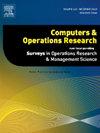An adaptive large neighborhood search method for the drone–truck arc routing problem
IF 4.1
2区 工程技术
Q2 COMPUTER SCIENCE, INTERDISCIPLINARY APPLICATIONS
引用次数: 0
Abstract
For applications such as traffic monitoring, infrastructure inspection, and security, ground vehicles (trucks) and unmanned aerial vehicles (drones) may collaborate to finish the task more efficiently. This paper considers an Arc Routing Problem (ARP) with a mixed fleet of a single truck and multiple homogeneous drones, called a Drone–Truck Arc Routing Problem (DT-ARP). While the truck must follow a road network, the drone can fly off of it. With a limited battery capacity, however, the drone has a length constraint, i.e., the maximum flight range. A truck driver can replace a battery for the drone after each flight trip. We first transform the DT-ARP into a node routing problem, for which we present a MIP formulation for the case with a truck and a drone. To solve large-size instances with multiple drones, a heuristic method based on Adaptive Large Neighborhood Search is proposed. The performance of ALNS is evaluated on small-size randomly generated instances and large-size undirected rural postman problem benchmark instances. In addition, an analysis is provided on the relationship between truck/drone speeds and the drone’s flight range, which affects the difficulty level to solve. The robustness of ALNS is shown via numerical experiments.
无人机-货车圆弧路径问题的自适应大邻域搜索方法
对于交通监控、基础设施检查和安全等应用,地面车辆(卡车)和无人驾驶飞行器(无人机)可以协同工作,以更有效地完成任务。本文研究了一个由一辆卡车和多架同构无人机组成的混合车队的圆弧路由问题,称为无人机-卡车圆弧路由问题(DT-ARP)。虽然卡车必须沿着道路网络行驶,但无人机可以飞离道路网络。然而,由于电池容量有限,无人机有长度限制,即最大飞行范围。卡车司机可以在每次飞行后为无人机更换电池。我们首先将DT-ARP转换为节点路由问题,并针对卡车和无人机的情况给出了MIP公式。针对多无人机的大型实例,提出了一种基于自适应大邻域搜索的启发式算法。在小尺度随机生成实例和大尺度无向农村邮差问题基准实例上对该算法的性能进行了评价。此外,还分析了卡车/无人机速度与无人机飞行距离之间的关系,影响了问题的求解难度。数值实验证明了该算法的鲁棒性。
本文章由计算机程序翻译,如有差异,请以英文原文为准。
求助全文
约1分钟内获得全文
求助全文
来源期刊

Computers & Operations Research
工程技术-工程:工业
CiteScore
8.60
自引率
8.70%
发文量
292
审稿时长
8.5 months
期刊介绍:
Operations research and computers meet in a large number of scientific fields, many of which are of vital current concern to our troubled society. These include, among others, ecology, transportation, safety, reliability, urban planning, economics, inventory control, investment strategy and logistics (including reverse logistics). Computers & Operations Research provides an international forum for the application of computers and operations research techniques to problems in these and related fields.
 求助内容:
求助内容: 应助结果提醒方式:
应助结果提醒方式:


